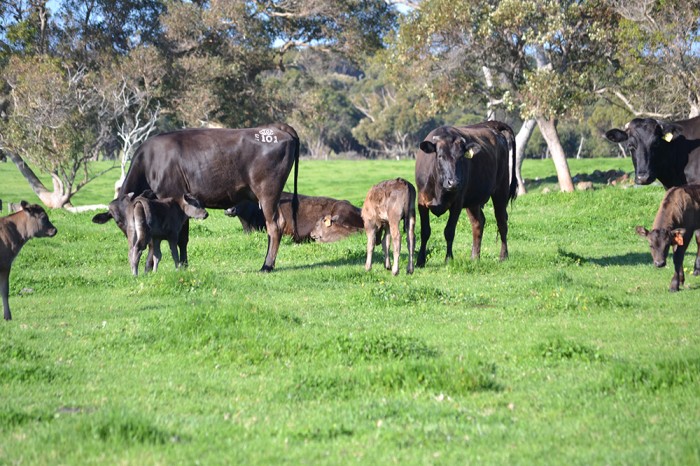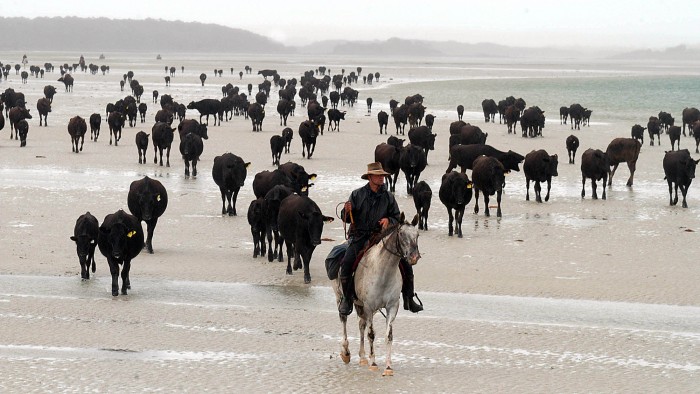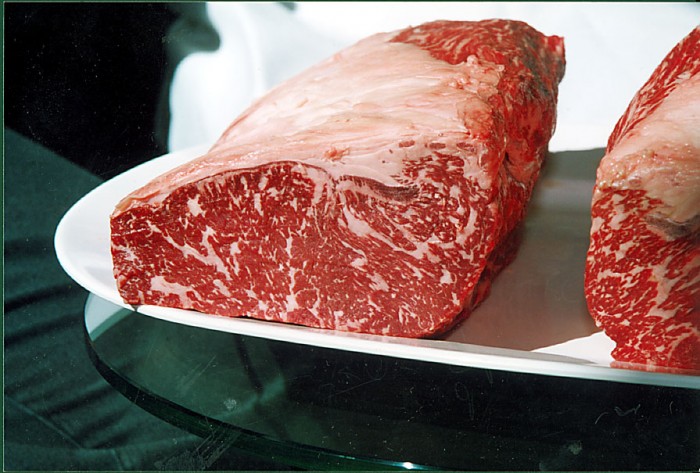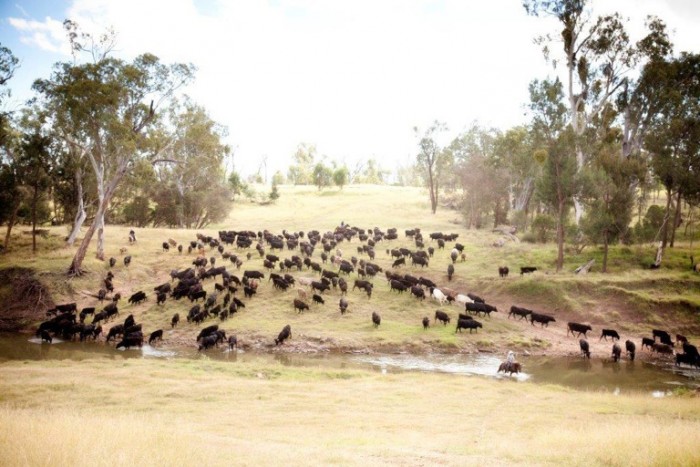Australia is one of the largest beef exporters in the world and Wagyu beef, which is known internationally for its quality and fatty well-marbled texture, occupies the upper end of the market. Wagyu beef has gained a reputation as a superior product and commands a high price as it is has a delicious taste and is high in mono-unsaturated fat which reduces the risk of cardio vascular disease.
The term Wagyu is of Japanese origin and literally means Japanese beef. The arrival of this breed in Australia is interesting and is explained by Graham Truscott, Executive Officer of the Association, “The Wagyu breed started in Australia only about 20 years ago during the late 1980’s and some of the key founders at that time were players like Chris Walker and the De Bruin family who exported Wagyu genetics out of Japan to the United States, because of Australia’s quarantine restrictions and therefore they then took the genetics from the U.S. and imported them into Australia.

The Japanese initially allowed that export to occur, but through pressure from their breeders who wanted to protect and retain the genetics themselves within Japan, the government declared the product, the Wagyu breed and Wagyu genetics, to be a national treasure and so shut down the export market for genetics out of Japan.
So the window of opportunity for these genetics from Japan was only about four years during the 1990’s. So during that time the breed has been grown in Australia and it is up to the point where it is now clearly recognised in Australia and internationally as the premium brand. So it is interesting that a brand called Wagyu has emerged so quickly without any major marketing really, to be the paramount beef product on the world scene.”
Wagyu beef quickly became popular and has been adjudged to be “tender, extremely juicy, with rich textures and plenty of flavour and a pleasant lasting taste on the palate” in the Australian Wagyu Association – Branded Beef Competition. It has significant health benefits and contains more conjugated linoleic acid (CLA)-Omega 6 per gram than any other foodstuff. The amount of CLA in Wagyu beef exceeds that in other beef by 30%. CLA is known to be a powerful anti-carcinogenic and possesses anit-inflammatory properties.
The high level of marbling in Wagyu beef gives it a unique flavour and taste and is responsible for its health enhancing properties. Marbling is the visible form of intramuscular fat which appears within the muscle and the extent of marbling is the result of genetics and nutrition. AUS-MEAT Limited, an industry owned company, has developed a grading system to ensure the standardised measurement of quality. Fullblood Wagyu beef has the highest marbling scores and crossbred Wagyu has lower scores.
The Australian Wagyu Association and its role
The Australian Wagyu Association was constituted in 1989 with the purpose of being the official voice of the Wagyu breed in Australia and representing its members. It maintains a rigorous and comprehensive breed registry and DNA records with a view to uphold the integrity of the Wagyu brand and enhance its reputation. The Australian Wagyu Association has also tasked itself with maintaining relations with government and media and ensuring truth in labelling for the Wagyu product in the market.
The members of the Association include growers of Wagyu cattle, both in Australia and overseas. Processors and downstream distributors of Wagyu beef are also members.
Graham Truscott explains, “We have got around about 350 members and 50 of those are overseas members and we probably represent maybe half the Wagyu breeders in Australia. Most of our breeders breed both feedstock for bull production and are also commercial breeders, because the value of the carcasses of these Wagyu cattle is so high that they focussed a lot more on commercial production than they have on feedstock and genetics production.”
Genetics of Wagyu cattle
A critical function of the Association is to identify the genetic traits that give the Wagyu breed its superior beef quality and then utilise this knowledge to increase the commercial value and success of Wagyu beef. Clarifying the role of genetics, Graham Truscott says, “The key drivers for any breed are the ability to be able to predict the genetics and their performance,so that we can pick which ones are the superior traits to use with this particular breed. This had not been done well until about two years ago.
We have been driving very hard into genetic analysis and the fundamental claim to fame of Wagyu is its carcass quality particularly in terms of the marbling of the breed. Therefore over the last two-three years, we have been taking end point carcasses information from abattoirs and feeding that into our genetic analysis system called Wagyu plan. We are developing estimated breeding values to be able to predict the carcass weight, the marbling capabilities of the carcass and the fineness of marbling.
We can very accurately predict the carcass that is going to be delivered from the genetics. That has been a key policy driver – to be able to achieve that, we need to understand where the elite genetics are and people can then breed from them and continue to genetically improve this breed. Wagyu has got massive upside potential in that area.
We have developed an index to be able to rank these Wagyu animals as feedstock animals. In the last four months we have been able to identify some superior bulls which are remarkably better than anything that anybody thought was possible. The leading bull identified in the last two days has produced progeny with a carcass value in the order of $700 better than the average bull that we have analysed.
Sadly we have identified him too late, because he’s actually now dead. But if he were alive and artificial insemination with that bull was used it would be quite possible to inseminate 1000 females and produce 1000 cows a year from that bull. Therefore that bull is producing commercially $700,000 worth of value better than the average Wagyu bull. So the ability of the genetics now that we are identifying them as superior ones is quite remarkable and at a level never seen before in the world beef industry.”
In addition to genetics, the quality and taste of Wagyu beef derives from the grain it is fed for up to 600 days. The cattle are kept in a feedlot and the grain they are fed is nutritionally balanced and consists of high energy feed such as barley, wheat sorghum and corn.
Wagyu beef is at the premium end of the market but forms a relatively small portion of the total beef industry. Exports take up 70% to 80% of the production. Graham Truscott says, “At the moment the breed is still extremely small relative to the Australian beef industry. We only represent around 170,000 matings or joinings per year that are Wagyu based and of that around about 20% are what we call full blood that means that they have an unbroken pedigree back to the original animals that came out of Japan.
Cross breed joinings, where a full blood is mated with another breed like an Angus, to produce a cross breed animal forms the remaining 80%. So therefore that’s the size of the breed at the moment and a measure of feedlot value and all these animals principally are fed, they currently are around about 7% of the feedlot cattle turnoff but because they are such high value carcasses they represent 17% of the feedlot carcass value.”
Investments in the future and upcoming research
The Association has initiated research which would enable it to predict the genetic performance of Wagyu cattle by taking and analysing DNA samples from a very young animal, say from a day to three months old. Preliminary runs on this technology have already been done.
Graham Truscott explains why this technology is of great importance, “It is very much needed in this breed, because the time between, say a mating of an animal and the conception of a progeny and the time that the progeny is slaughtered, so you actually know how it performs, could well be three years. So it takes a long time to assess using carcass information how well the sires are performing, so the opportunity to be able to use a genomic analysis through a DNA test and predict a performance at a young age is really important for this breed.”
Goals of the Association
The Australian Wagyu Association has set for itself the goal of having its genetic analysis work fully accepted and utilised within the Australian and international Wagyu beef industry. It is also working towards using genomic analysis to establish the genetic performance of Wagyu cattle with the purpose of predicting the animal’s performance at a very young age.
Wagyu beef enjoys the distinction of being famous for its high quality, delicious taste and health-enhancing attributes. Its strength lies in the brand that it has built for itself over the years and it is imperative that this be preserved and enhanced. The Australian Wagyu Association has amply demonstrated its ability to strengthen and uphold the reputation of Wagyu beef and improve its commercial value.





 This information will never be shared to third parties
This information will never be shared to third parties